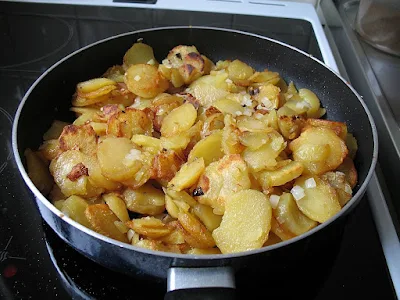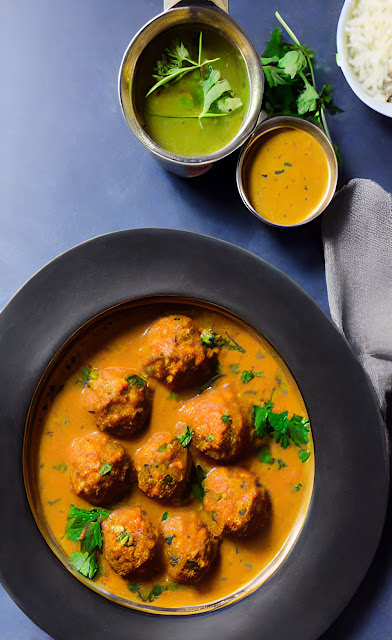Fried Fish from Hamburg with Potatoes (Hamburger Pannfisch mit Bratkartoffeln)
The name comes from the German dialect used in the northern part of the country, where Pfannes is a pan, Fisch is fish, and Hamburger is, as you know, the city of Hamburg.
Basically, it's fried fish served with mustard sauce.
As the name suggests, it's a typical preparation from the city of Hamburg, known for its proximity to the sea and its seafood cuisine.
Pannfisch is typically made with herring, plaice, or cod actually with pollack, often passed off as cod which is fried and then covered with a mustard sauce. Although not mandatory, the dish is usually complemented with bratkartoffeln (fried potatoes with bacon and onion).
So, the usual composition of the dish is a base of bratkartoffeln, on top of which is the fish, all bathed in mustard sauce. It's also common for the sauce to be served separately, allowing the diner to use it as they please. It's one of the best fish dishes out there.
By the way, in Hamburg, don't look for the famous hamburgers because they don't exist under that name. The original recipe for hamburgers is called "buletten." When in the United States they saw that German immigrants, most of whom departed from the port of Hamburg, ate buletten, they called that minced meat preparation hamburgers.
INGREDIENTS (serve 4):
- 4-8 fillets of plaice, herring, pollack, cod, etc.*
- 250 ml (1 cup + 1/4) milk
- 100 ml (1/2 cup) cooking cream
- 2 tablespoons strong mustard
- 1 tablespoon granulated mustard**
- 1 small red onion
- 1 tablespoon butter
- A pinch of sugar
- White wheat flour
- Sunflower, corn, or canola oil
- Salt
- Ground black pepper
* It's common to serve 200 grams (7 oz) of fish per diner, regardless of the fillet's size. Adjust the units based on the targeted weight. Smaller fish may require more fillets.
** Granulated mustard is a coarser type commonly used in Germany and France, where the grains are still perceptible. You can omit it by using a bit more strong mustard, although the original recipe employs this type.
1. Make Mustard Sauce:
Chop the onion and fry it in a tablespoon of butter. When it becomes translucent, add a tablespoon of flour and toast it. Once it turns brown, add milk and bring to a boil. Reduce the heat and cook for 5 minutes, then remove from heat.
Immediately add cooking cream, mustard, salt, ground black pepper, and a pinch of sugar, stirring well. Reserve, keeping it warm (you can keep it on low heat or in the oven at a maximum of 50 degrees Celsius / 122 F).
2. Prepare the Fish:
Wash the fish fillets, pat them dry, season with salt and pepper, and coat them in flour.
Fry them on both sides for 2-3 minutes until golden. Use vegetable oil for frying and place the fillets on absorbent paper to remove excess grease after frying.
To prepare the Bratkartoffeln (Fried Potatoes)
INGREDIENTS:
- 1 kg (2.2 lb) potatoes
- 100 grams (3.5 oz) unsalted butter
- 200 grams (7 oz) bacon strips (optional)
- 2 red onions (optional)
- Salt
- Black pepper
- Chives, caraway seeds (optional)
It's best to use potatoes that resist cooking without breaking. Therefore, for instance you should Kennebec potatoes or similar, while if you are in Germany, Linzer, Kipfler, or Sieglinde potatoes, among others, would be suitable.
1. Boil the Potatoes:
Wash the potatoes thoroughly and place them in a pot with a handful of salt and enough water to cover them.
Depending on the size, they may take between 30 and 50 minutes to cook with the lid on and over medium heat. To check if they are done, pierce them with a knife; the blade should penetrate, but not as easily as it would in a piece of hot butter (they should remain firm).
Once they are cool enough to handle, peel the potatoes.
It's best to let them cool completely, even storing them in the refrigerator, before frying them the next day. If you can't wait that long, at least let them cool completely. It's important that they are firm and cold when frying.
2. Fry the Potatoes:
Firstly, fry the potatoes in clarified butter to prevent it from burning at the high frying temperature. If using butter makes you uneasy, you can replace it with olive oil or mix regular butter with it to reach an optimal temperature without burning while maintaining the desired German potato flavor.
To clarify butter, heat it in a saucepan until completely melted. Let it rest, and in a few seconds, the yellowish liquid will have stratified into three layers. The top layer is like foam and can be removed with a slotted spoon or a spoon. The next layer, clearer and in larger quantity, is the clarified butter that separates from the whey at the bottom through simple decantation.
Cut the potatoes into half-centimeter (0.2 inches) thick slices. It's essential that all slices have the same thickness to fry evenly.
Pour some of the clarified butter into a pan over medium-high heat. When it's hot, fry the potatoes, being careful not to stack them and ensuring they don't touch each other. Since they are somewhat thick, it's typical to leave them for about 3 minutes on each side until the edges darken. Repeat this process for all slices. Once removed, let them rest on a paper towel to absorb excess butter.
In another pan, also with a bit of clarified butter, fry the onion rings until crispy.
In the same pan, sauté the bacon strips. These ingredients are not always added, but it's common if it's going to be a main dish.
Finally, mix the fried potatoes with the onion and bacon, seasoning everything to taste.
It's also customary to add chopped chives and caraway seeds.
If you don't want to use clarified butter, you can fry the potatoes in oil, adding a tablespoon of butter to achieve a flavor very similar to the original recipe but with fewer calories.
How to serve:
If you have prepared fried potatoes, arrange them at the bottom of the plate, place the fish fillets on top, and pour the mustard sauce over everything, all served hot.
With this recipe, it's hard for anyone to refuse to eat fish.





Comments